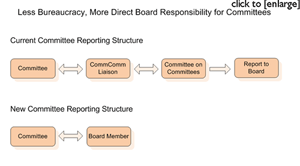Committees, Communication, and Commitment
Key Changes
The workgroup’s recommendations eliminate these extra layers through two major changes that will occur in January 2010, assuming approval of the bylaw changes in December. The first is creation of committee councils for awards, education, membership, and professional issues and visibility. These councils are not new committees, much less another layer of bureaucracy. Instead, councils will facilitate board oversight of committees by providing regular, direct communication between committee chairs in related areas and designated board members. Councils also will assist committees in working with each other on issues of common interest and in recommending actions to the board. The past president will chair the Council for Awards, and vice presidents will chair the councils for education, membership, and professional issues and visibility.
The Council for Awards will be responsible for making recommendations to the board on all matters relative to awards and awards policy, including consideration of new awards and the consolidation or elimination of awards.
The Council for Education will comprise—along with education committee chairs—representatives from the Section on Statistical Education, the Section on Teaching of Statistics in the Health Sciences, and the ASA Education Department staff. This council will provide guidance to the board regarding statistics education issues, and it will provide structure and processes through which initiatives, policies, and directions in statistics education can be identified and realized.
The Council for Membership will comprise committees that can support the membership growth area of the strategic plan in a broad sense by identifying ways to meet the needs of underserved groups (such as applied statisticians and young statisticians), considering ways to build and retain membership in traditional sectors of the ASA, and serving the needs of minority groups within the ASA.
The Council for Professional Issues and Visibility will comprise committees that build visibility and support for the statistics profession and promote the use of statistics in other fields. Within the strategic plan, this council can support the areas of public awareness and visibility and impact in policymaking.
As council chairs, vice presidents will maintain contact with committee chairs, lead high-level discussions at council meetings, and give annual presentations to the board that describe committee activities and provide recommendations that require board action. Vice presidents will not be expected to be experts in the council areas, nor will they be elected on that basis. On the other hand, council vice chairs will be appointed on the basis of significant domain experience.
The second major change is creation of a leadership support council (LSC), which will advise the board on the strategic use of committees. The LSC will be chaired by the president-elect. Four appointed members of the LSC will advise the president-elect on committee appointments and assist the vice presidents and past president by serving as vice chairs of the committee councils. The vice presidents and the past president also will serve on the LSC. The LSC is a new committee that will continue the function of the current Committee Appointments Advisory Committee (CAAC). Both the CAAC and the Committee on Committees will be dissolved at the end of 2009.
Transition to New Structure
During May and June, Committee on Committees liaisons presented a draft of the workgroup’s recommendations to committee chairs. Overall, the chairs supported the recommendations, indicating that direct contact with a board member would help committees be better connected with the ASA and that being able to share concerns and successes with other chairs would be valuable. Following the board endorsement on July 31, the workgroup chair presented the new structure to committee chairs at their JSM meeting on August 2.
This fall, ASA Vice President Alicia Carriquiry will oversee the transition to the new structure. The goal of the transition plan, described in the workgroup’s report, is to establish and fully prepare the LSC, together with council chairs and vice chairs, for their new roles, which will commence in January. In the meantime, the Committee on Committees will continue to communicate with committee chairs.
Benefits
The new structure will strengthen and energize the ASA’s committee structure. Committee chairs will have a direct line of communication with designated board members and the opportunity to learn from each other. Committees will be better used, with work that is visibly aligned with the strategic plan. Presidents-elect will be advised on using committees to accomplish strategic goals and receive assistance with appointments. Also, ASA members will be better informed about committee contributions.
Brian A. Millen, chair of the Committee on Minorities in Statistics, summed up the new structure when he said, “What’s ultimately important is the impact and alignment of each committee’s activities with the mission, vision, and strategic direction of the ASA. The new structure emphasizes more streamlined, direct communication between committees and the board. This is a clear positive.”


















